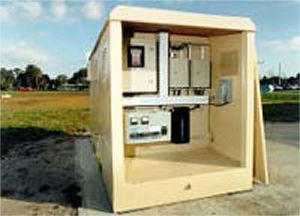
|
|

|
|
| Distributed Generation |
Information Monitors has worked extensively with utility companies, government, and industry to develop design specifications to monitor the performance and health of disrtributed power generation systems. Some of our current projects include hybrid systems, standalone and grid-connected photovoltaic (PV) systems, and photovoltaic lighting systems. Hybrid systems incorporate multiple energy sources. In addition to PV, they may use a diesel generator or wind turbines to provide power for lighting, refrigeration, or communications in remote areas. We are currently studying a PV-diesel hybrid power system with integrated supervisory control and data acquisition (SCADA).
Diesel engine generator and controls for PV hybrid system Telecommunications using new satellite constellations operating at high frequency allows for wireless control and monitoring of the performance and health of remote systems at affordable costs. Standalone systems produce power independently of the utility grid; hence, they stand alone. The simplest type of standalone PV system is a direct-coupled system, where the DC output of the module or array is connected directly to a DC load. The direct-coupled system has no electrical energy storage (batteries), so the load operates only during sunlight hours. However, most systems rely on batteries to store electricity for use at night or during cloudy periods. A charge controller may be added for battery protection, and an inverter to run AC loads. Standalone systems comprise the majority of photovoltaic installations in remote regions of the world because they are often the most cost-effective choice for applications far from the utility grid. Grid-connected systems, which can draw electricity from and feed electricity back to the grid, must incorporate a number of design considerations different from those included in standalone systems. We test and evaluate grid-connected systems to address major interconnection issues such as equipment protection, power quality, and personal safety.
In typical PV lighting systems, the light source is powered by a battery,
which is recharged during the day by the PV array. Electronic controls are
used between the battery, light source and PV array to protect the battery
from overcharge and overdischarge, and to control the timing and operation
of the light.
|

|
